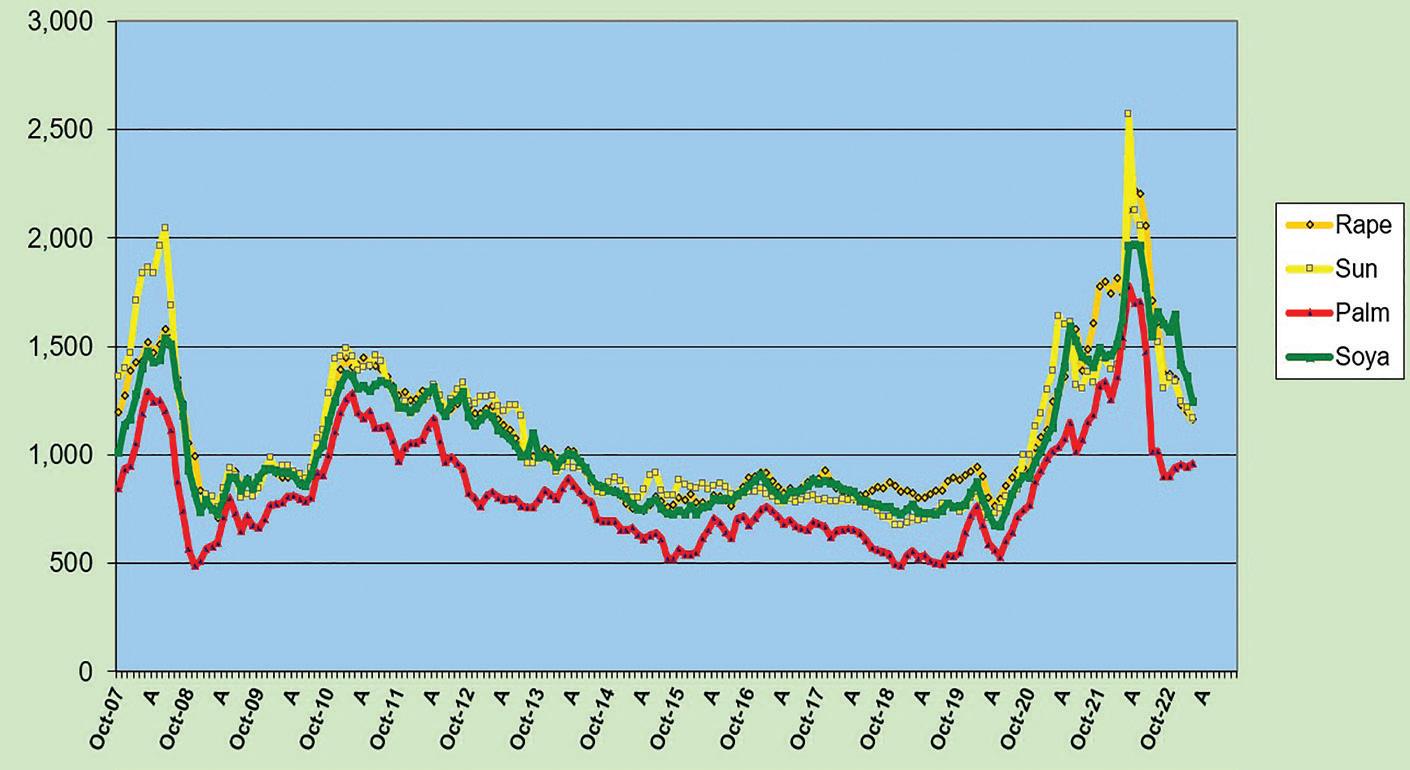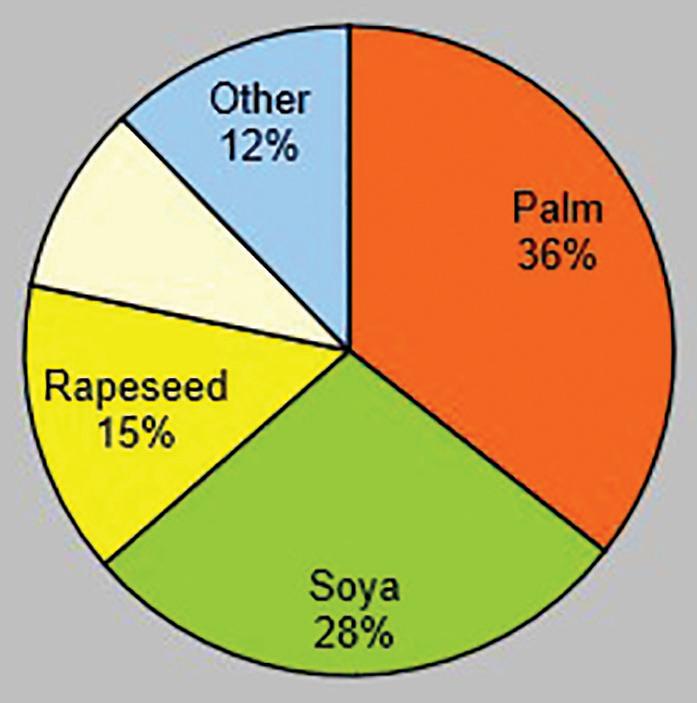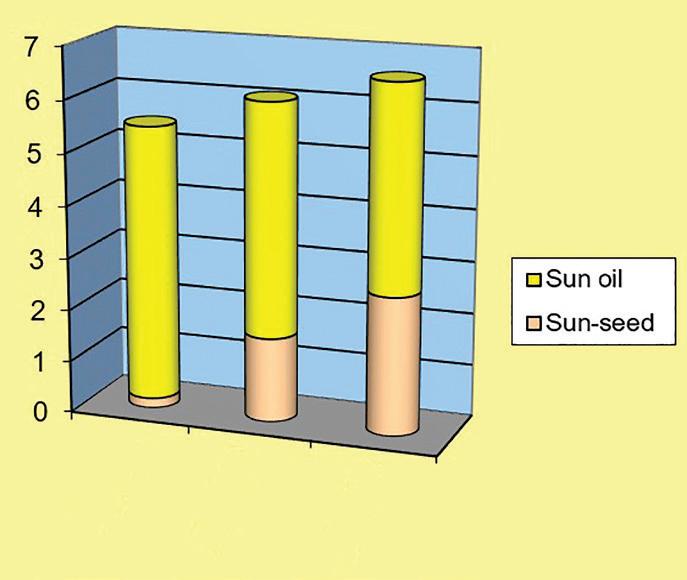
7 minute read
Will supply meet demand?
Concerns over wet weather in Malaysia and Indonesia’s export policy dominate palm oil supply forecasts. Meanwhile, a protracted drought in Argentina will hit its soyabean production but a record crop from Brazil will still allow a rise in global soya output
John Buckley
Supply concerns emerging since the New Year have not prevented crude edible oil prices dropping to some of their lowest levels in two years (see Figure 1, right). While several recent analyses maintain significant growth is still possible for total vegetable oil production, doubts persist over the ability of top palm and soyabean oil exporters – Indonesia and Argentina respectively – to meet demand at levels expected a few months back. So will prices rise again?
The four major vegetable oils that make up 88% of global production have been expected to meet the expected 4%-plus rise in world supply for the 2022/23 season, preventing a price-boosting stock drawdown (see Figure 2, following page).
Doubts that have emerged for toptraded palm oil have focused largely on two factors. One is some excessive wet weather issues for second-largest producer Malaysia, which could miss targets in the second half of this year if an El Niño system develops.
Possibly even more important is how leading palm oil supplier Indonesia conducts its export policy in relation to its programmes to protect domestic consumers from price rises and shortages.
The threat to Indonesian supplies is less about weather and other factors that might affect actual production than its plans to use ever more palm oil in its fast-expanding biodiesel sector, crimping supplies for export. Indonesia’s huge population of food oil consumers and its vast industrial use already make it the largest global consumer of palm oil as well as the fourth largest user of vegetable oils in total. Will it really be able to expand its palm exports, as the US Department of Agriculture (USDA) recently estimated, from 22.3M tonnes in 2021/22 to 28.45M tonnes in 2022/23? The question is key as that gain has been forecast to supply over 80% of the expected increase in global 2023/24 vegetable oil output).
The market had an example of Indonesian influence last year, when its sudden halt to exports helped propel global vegetable oil prices to record highs – almost US$1,700/tonne equivalent on Bursa Malaysia palm oil futures.
The resultant excessive stock buildup inside Indonesia – and the strenuous efforts it then made to move that surplus back into exports – saw prices briefly crash to under US$700/tonne, The subsequent recovery, back into the US$900s/tonne as we went to press, has demonstrated the trade’s unease with the way supply might shape up in the next few months, especially if a post-COVID lockdown China returns to its usual role as the world’s second largest palm oil importer – just when other demand steps up ahead of the Ramadan season.
Palm oil customers have also been rattled in early 2023 by reports that Indonesia wants to conduct its crude palm oil export business through a futures exchange pricing mechanism from June onwards, although refined exports would still be allowed to bypass that. Indonesian officials suggest such a system need not raise costs but buyers are nervous about this latest policy swerve.
Soya ‘glut’ no more?
A few months ago, some analysts were expecting soya to be in possible oversupply amid record Latin American crops and a possible bumper one in the USA. Top importer China, meanwhile, was aiming to hike domestic production (already up 4M tonnes or 24% this season), potentially restraining its need for imports (normally over half the world’s total).
Since then, things have gone dramatically wrong for number three producer and top soyabean oil exporter Argentina, whose larger sown area has been cursed by protracted drought. From around 51M tonnes at sowing time, its crop outlook has shrunk recently to 2733M tonnes, equivalent to the loss of some 4.5M tonnes of soyabean oil supply. Offsetting that has been Brazil’s more successful growing season, promising to produce a record 150M tonnes from its own much larger sown area, equal to an extra 3.8M tonnes of soyabean oil.
The bottom line remains more global soyabean crush than last season, so more bean and product exports in total but the market is still attempting to respond to this lower than expected gain. How will US farmers react? Planted area there was expected to rise in a switch away from more input-hungry grains. In mid-February, the USDA’s annual Outlook Forum came up with 35.4 8M planted hectares of soyabeans, not so different from last year but with higher yield potential, given better weather than last year. This is the basis for a possible 122.5M tonnes crop, up by more than 4M tonnes.
The US futures market has soyabean prices dropping this year by about 10% from over US$15/bushel to around US$13.50/bushel while soyabean oil retains more value, showing a mere 2.7% decline. Some of the soyabean oil strength has derived from forecasts u of higher bio-diesel use, with the USDA estimating a further increase after rising from 4.05M tonnes in 2020/21 to about 4.7M tonnes in 2021/22 and 5.26M tonnes for the current season.




































The USDA expects world soyabean oil output to increase by 1.9M tonnes or 3.2%, contributing 20% to the global rise in total vegetable oil supply.
Canola/sunflowerseed outlook
Coming out of a much better than expected crop performance in the 2022/23 season, rapeseed – like sunflower oil – still faces supply risks from the Black Sea conflict’s impact on Ukraine’s sowing, harvest, crush and marketing of oilseeds.

Ukraine’s 2022 rapeseed crop was its second best ever at an estimated 3.3M tonnes. Russian output also jumped to 3.9M tonnes.
The EU 2023 winter-sown crop so far seems in fine shape under generally favourable weather conditions, according to the French analyst Strategie Grains which estimates the bloc’s potential at around 19.6M tonnes. However, traders are keeping an eye on drier conditions in recent months for France and parts of Germany and the UK.

Canada’s steep 2022 crop rebound continues to restrain prices across the canola market. Its 19M tonnes harvest (+5.25M tonnes) left end of 2022 stocks of 11.36M tonnes, 29% higher than the previous year’s. This has also allowed domestic crush to recover by 9.6% to 5.2M tonnes and exports to rise 27.5% to 4.3M tonnes for the season so far.
Canada’s crush margins have also remained very strong, with processors running close to full capacity.
Comfortable supplies will be welcomed by those companies expanding capacity.
Although Ceres has reportedly suspended its plans for now, Cargill, Federated Coop AGT, Richardson and Viterra are all going ahead with constructions that should ultimately boost crush by at least 6M tonnes/year.
Based on forecasts of slightly higher usage in 2023/24, Canada’s carryover stocks could stay much lower than normal – some say around 850,000 tonnes compared with the five-year average of 2.26M tonnes. That could keep the season’s average price higher than the five-year mean of C$739 (US$536).
Fortunately for consumers, Australia is forecast to produce as much as 8.3M tonnes this season, compared with 6.8M tonnes last season and just 4.8M tonnes in 2020/21. After some weather challenges in the past year, this continued growth is testament to investments made in disease management and farm practice in recent years, analysts say. Although government forecaster Abares is pencilling in a smaller crop for 2023/24, it expects exports to stay strong at around 7M tonnes against the average of only 2.15M tonnes over the five years prior to 2022/23.
In contrast, observers have been trimming back expectations for growth in India’s rapeseed crop. After farmers boosted sowings by some 9%, this was initially expected to approach a new record, perhaps as large as 12M tonnes. However, some observers now think frosts and heatwaves may prevent much growth from last year’s level of 11M tonnes.
Consumption of rapeseed oil is forecast by the USDA to grow by over 8% or about 2.4M tonnes this season, led by China, India, the EU and Canada. However India’s demand could be curbed by its weaker than expected crop and China’s by a slower than expected recovery in its ‘postCOVID’ demand for food oils. Although the EU has been forecast to raise demand by about 350,000 tonnes this season, its longer term consumption remains under threat from the tarnishing image of feed and food crops being used for fuel. Germany’s biofuel industry body recently said its government was considering phasing these out by 2030.
Sunflower oil supplies fared better than expected amid the conflict between the Black Sea region’s leading producers.
Able to draw on huge stocks carried in from the 2021/22 season, Ukraine managed to keep crush at a respectable 10.8M tonnes against the previous season’s 11.35M tonnes, and oil output at 4.39M tonnes (versus 4.64M tonnes the previous season). Using the Black Sea corridor and other routes, it is also expected to ship 2.65M tonnes of sunflowerseed in 2022/23 – 1M tonnes more than in 2021/22 and against just 191,000 tonnes in 2020/21 (see Figure 3 left). That should help raise global production of the oil from last year’s 19.8M tonnes to some 20.6M tonnes.
By early 2023, easing supplies had helped bring the monthly average price of crude sunflower oil down from a record US$2,570/tonne in March 2022 to US$1,168/tonne in February 2023. Overseas buyers were quick to take advantage of this. India – with the added incentive of duty-free imports until March, took a record 473,000 tonnes in January, three times its normal monthly level.
However, while the Black Sea producers have recently been active cheaper sellers, the mid/longer-term outlook for Ukrainian production and exports remains uncertain. This means the global market is expected to start the next season with far lower carryover stocks of sunflowerseed –about 4.4M tonnes compared with the 8M+ tonnes in 2022/23. That could leave 2023/24 supply – and cost – at much greater risk from crop weather or adverse developments in Ukraine. ● John

With different production processes for biodiesel and renewable diesel, what are the pros and cons of one versus the other and the specific advantages of soyabean oil as a feedstock?

Erica Curles and Keith Cockerline
Biodiesel starts as an oil. It could be vegetable oil, such as soyabean oil, yellow grease, used cooking oils, or animal fats.
The process of making biodiesel via the fatty acid methyl ester (FAME) method requires feedstock oils/fats, a solvent such as hexane or methanol, and a catalyst as inputs (see Figure 1, following page).
Processing starts by putting the oil into a reactor with a solvent and a catalyst, then a separator to remove glycerol, creating glycerine as a useful by-product. The remaining product, composed of methyl esters, goes through cleaning steps to remove the solvent, neutralisation with acid and drying, resulting in biodiesel.
Biodiesel has its challenges, namely that it thickens in cold temperatures when










